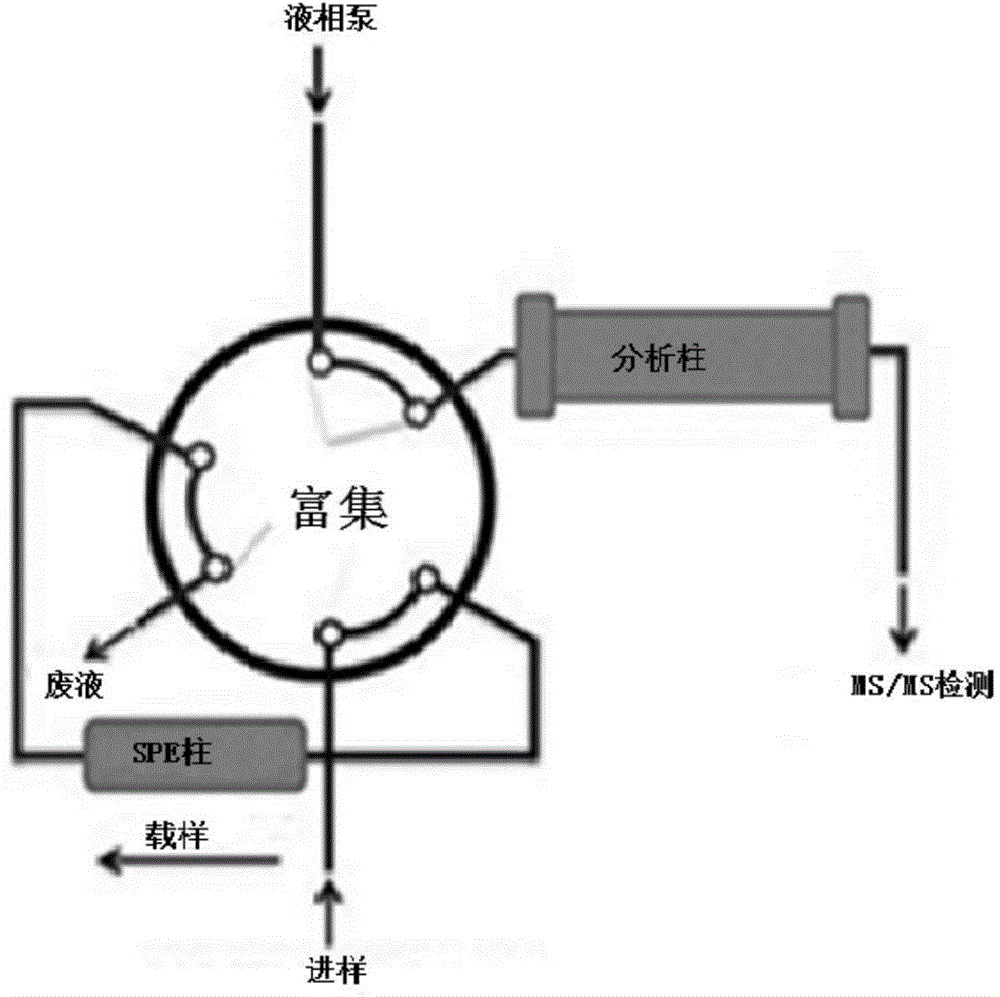Pretreatment and detection method for biogen amine neurotransmitter and detection kit
A neurotransmitter, biogenic amine technology, applied in the field of detection, can solve the problems of reduced recovery rate, complicated steps, poor stability of biogenic amine neurotransmitters, etc., and achieves the effects of rapid determination, high sensitivity, and avoiding instability
- Summary
- Abstract
- Description
- Claims
- Application Information
AI Technical Summary
Problems solved by technology
Method used
Image
Examples
Embodiment 1
[0098] Example 1: Determination of biogenic amine neurotransmitters and their metabolites (1)
[0099] 1. Reagents and materials used:
[0100] Rat blank brain tissue homogenate: the rat was decapitated, the skull was carefully cut and the brain tissue was taken out. Accurately weigh rat blank brain tissue, add 9 times the volume of 10 mM ascorbic acid aqueous solution, and use a high-speed homogenizer to homogenize to obtain a 10% rat blank brain tissue homogenate.
[0101] Internal standard solution: acetaminophen solution diluted in acetonitrile.
[0102] Neurotransmitter standard solution: prepared by adding 10 mM ascorbic acid aqueous solution to the biogenic amine neurotransmitter standard. Wherein, biogenic amine neurotransmitter standard products were purchased from Sigma Company.
[0103] Sodium carbonate-sodium hydroxide buffered saline, and 1 mg / mL p-dimethylaminobenzenesulfonyl chloride in acetonitrile.
[0104] Wherein, p-dimethylaminobenzenesulfonyl chlorid...
Embodiment 2
[0137] Example 2: Stability study of biogenic amine neurotransmitters and their derivatized products
[0138] 1. Experimental method:
[0139] Investigate the stability of various biogenic amine neurotransmitters and their metabolites in different pH media and other conditions, and the stability of biogenic amine neurotransmitter derivative products.
[0140]Accurately weigh biogenic amine neurotransmitters or their metabolites, and prepare a 1 mg / mL solution with 10 mM ascorbic acid aqueous solution. Dilute with 1% formic acid (pH=1), 10mM ammonium acetate (pH=5) and artificial cerebrospinal fluid (pH=7.4) respectively, so that the concentrations are 10ng / mL, 100ng / mL and 1000ng / mL or 40ng / mL, 400ng / mL and 4000ng / mL. The sample was placed at 37° C., 50 rpm, and heated for 0, 2, 4, 8, 16 and 24 hours respectively to terminate the heating. Take each sample and derivatize biogenic amine neurotransmitters or their metabolites according to the method of Example 1, place the d...
Embodiment 3
[0148] Example 3: Determination of biogenic amine neurotransmitters and their metabolites (2)
[0149] 1. Determination method:
[0150] Referring to the assay method of Example 1.
[0151] The difference is that the derivatization reagent solution uses benzenesulfonyl chloride in acetonitrile solution with a concentration of 1 mg / mL. The ion pairs and mass spectrometry conditions corresponding to the quantitative analysis of biogenic amine neurotransmitters and their metabolites are shown in Table 6.
[0152] Table 6
[0153]
[0154]
[0155] 2. Measurement results:
[0156] 2.1 Draw a standard curve:
[0157] Accurately weigh the solid powders of sodium chloride, potassium chloride, calcium chloride, magnesium chloride, disodium hydrogen phosphate and 4-hydroxyethylpiperazineethanesulfonic acid (HEPEs) into 1L of double-distilled water, shake and dissolve, so that they contain 147mmol / L sodium chloride, 3mmol / L potassium chloride, 1.2mmol / L calcium chloride, 1....
PUM
 Login to View More
Login to View More Abstract
Description
Claims
Application Information
 Login to View More
Login to View More - R&D
- Intellectual Property
- Life Sciences
- Materials
- Tech Scout
- Unparalleled Data Quality
- Higher Quality Content
- 60% Fewer Hallucinations
Browse by: Latest US Patents, China's latest patents, Technical Efficacy Thesaurus, Application Domain, Technology Topic, Popular Technical Reports.
© 2025 PatSnap. All rights reserved.Legal|Privacy policy|Modern Slavery Act Transparency Statement|Sitemap|About US| Contact US: help@patsnap.com



